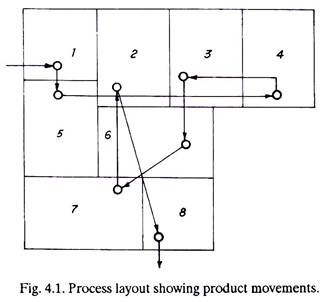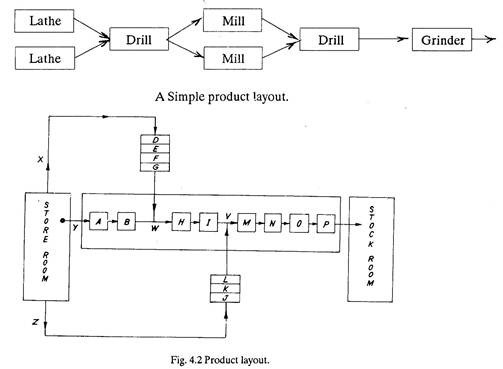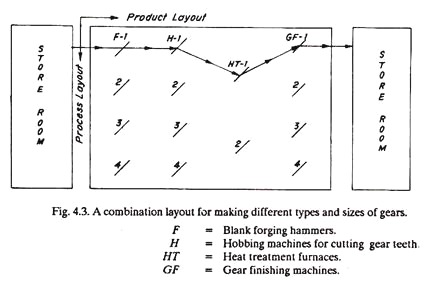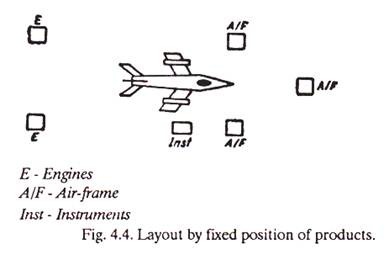This article throws light upon the five main types of layout. The types are: 1. Plant Layout 2. Process Layout 3. Product Layout 4. Combination Layout 5. Fixed Position Layout.
Type # 1. Plant Layout:
Plant layout means the disposition of the various facilities (equipments, material, manpower, etc.) and services of the plant within the area of the site selected previously. Plant layout begins with the design of the factory building and goes up to the location and movement of a work table. All the facilities like equipments, raw materials, machinery, tools, futures, workers, etc. are given a proper place. In deciding the place for equipment, the supervisors and workers who have to operate them should be consulted.
Objectives of Good Plant Layout:
In a good plant layout:
ADVERTISEMENTS:
(1) Material handling and transportation is minimized and efficiently controlled.
(2) Bottlenecks and points of congestions are eliminated (by line balancing) so that the raw material and semi-finished goods move fast from one work station to another.
(3) Work stations are designed suitably and properly.
(4) Suitable spaces are allocated to production centres and service centres.
ADVERTISEMENTS:
(5) The movements made by the workers are minimized.
(6) Waiting time of the semi-finished products is minimized.
(7) Working conditions are safer, better (well ventilated rooms, etc.) and improved.
(8) There is increased flexibility for changes in product design and for future expansion.
ADVERTISEMENTS:
(9) There is the utilization of cubic space (i.e., length, width and height).
(10) There are improved work methods and reduced production cycle times.
(11) Plant maintenance is simpler.
(12) There is increased productivity and better product quality with reduced capital cost.
ADVERTISEMENTS:
(13) A good layout permits materials to move through the plant at the desired speed with the lowest cost.
Principles of Plant Layout:
For the guidance of Plant Layout engineers, many principles of Plant Layout have been developed during past years. Besides these ready-made principles, considerable art and skill is required in designing a good plant layout. The research work is being continued in order to develop a scientific approach for solving plant layout problems.
Some of the outcomes are, the development of heuristic approach, mathematical models and computer aided computational techniques for balancing assembly lines.
ADVERTISEMENTS:
A few sound principles of plant layout have been briefed as under.
They are the principles of:
(a) Integration:
It means the integration of production centres facilities like workers, machinery, raw material etc., in a logical and balanced manner.
ADVERTISEMENTS:
(b) Minimum Movements and Material Handling:
The number of movements of workers and materials should be minimized. It is better to transport materials in optimum bulk rather than in small amounts.
(c) Smooth and Continuous Flow:
Bottlenecks, congestion points and back tracking should be removed by proper line balancing techniques.
ADVERTISEMENTS:
(d) Cubic Space Utilization:
Besides using the floor space of a room, if the ceiling height is also utilized, more materials can be accommodated in the same room. Boxes or bags containing raw material or goods can be stacked one above the other to store more items in the same room. Overhead material handling equipment save a lot of valuable floor space.
(e) Safe and Improved Environments:
Working places-safe, well ventilated and free from dust, noise, fumes, odours, and other hazardous conditions decidedly increase the operating efficiency of the workers and improve their morale. All this leads to satisfaction amongst the workers and thus better employer- employee relations.
(f) Flexibility:
In automotive and other industries where models of products change after some time, it is better to permit all possible flexibility in the layout. The machinery is arranged in such a way that the changes of the production process can be achieved at the least cost or disturbance.
Type # 2. Process Layout:
ADVERTISEMENTS:
It is also known as functional layout and is characterised by keeping similar machines or similar operations at one location (place). In other words, all lathes will be at one place, all milling machines at another and so on, that is machines have been arranged according to their functions. This type of layout is generally employed for industries engaged in job order production and non-repetitive kind of maintenance or manufacturing activities.
Figure 4.1 shows a process layout:
Advantages:
(1) Wide flexibility exists as regards allotment of work to equipment and workers.
(2) Better utilization of the available equipment.
ADVERTISEMENTS:
(3) Comparatively less number of machines are needed, thus involving reduced capital investment.
(4) Better product quality, because the supervisors and workers attend to one type of machines and operations.
(5) Varieties of jobs coming as different job orders make the work more interesting for the workers.
(6) Workers in one section are not affected by the nature of the operations carried out in another section. For example, a lathe operator is not affected by the rays of the welding as the two sections are quite separate.
Disadvantages of Process Layout (When Compared with Product Layout):
(1) For the same amount of production, process layout needs more space.
ADVERTISEMENTS:
(2) Automatic material handling is extremely difficult.
(3) More material-in-process remains in queue for further operations.
(4) Completion of same product takes more time.
(5) Work-in-process inventory is large.
(6) Production control becomes difficult.
(7) Raw material has to travel larger distances for being processed to finished goods. This increases material handling and the associated costs.
ADVERTISEMENTS:
(8) It needs more inspections and efficient co-ordination.
Type # 3. Product Layout:
It is also known as line (type) layout. It implies that various operations on raw material are performed in a sequence and the machines are placed along the product flow line, i.e., machines are arranged in the sequence in which the raw material will be operated upon. This type of layout is preferred for continuous production, i.e., involving a continuous flow of in-process material towards the finished product stage. Figure 4.2 shows a product type of layout.
Raw material from the store is fed to three lines X, Y and Z. Material in X line gets processed on machines D,E,F and G and meets material of Y line after it has been processed on the main assembly line machines A & B. Products of X and Y lines are assembled at W and get processed on machines H and I till another part comes from Z line and assembles with the main product at V. After that the total assembly gets worked on machines M, N, O and P and goes to the stock room. (The inspection phase has not been shown in the layout).
Advantages:
(1) Less space requirements for the same volume of production.
ADVERTISEMENTS:
(2) Automatic material handling, lesser material handling movements, times and costs.
(3) Less in-process inventory.
(4) Product completes in lesser time.
(5) Better co-ordination and simple production planning and control.
(6) Smooth and continuous work flow.
(7) Less skilled workers may serve the purpose.
Disadvantages as Compared with Process Layout:
(1) Since the specified product determines the layout, a change in product involves major changes in layout and thus the layout flexibility is considerably reduced.
(2) The pace or rate of working depends upon the output rate of the slowest machine. This involves excessive idle time for other machines if the production line is not adequately balanced.
(3) Machines being scattered along the line, more machines of each type have to be purchased for keeping a few as stand by, because if one machine in the line fails, it may lead to shut down of the complete production line. This is how product layout involves higher capital investments.
(4) Though it involves less supervision as compared to process layout, sometimes it (inspection) becomes difficult when one inspector has to look after many (say all welding) machines in two or more production lines.
(5) It is difficult to increase production beyond the capacities of the production lines.
Type # 4. Combination Layout:
A combination of process and product layouts combines the advantages of the both types of layouts. Moreover, these days pure product or process layouts are rare. Most of the manufacturing sections are arranged in process layout with manufacturing lines occurring here and there (scattered) wherever the conditions permit. A combination layout is possible where an item is being made in different types and sizes.
In such cases machinery is arranged in a process layout but the process grouping (a group of number of similar machines) is then arranged in a sequence to manufacture various types and sizes of products. The point to note is that, no matter the product varies in size and type, the sequence of operations remain same or similar. Figure 4.3 shows a combination type of layout for manufacturing different sized gears.
A combination layout is also useful when a number of items are produced in same sequence but none of the items are to be produced in bulk and thus no item justifies for an individual and independent production line. For example, files, hacksaws, circular metal saws, wood saws, etc. can be manufactured on a combination type of layout.
Type # 5. Fixed Position Layout:
Layout by fixed position of the product is inherent in ship building, aircraft manufacture (Fig. 4.4) and big pressure vessels fabrication. In other types of layouts discussed earlier, the product moves past stationary production equipment, whereas in this case the reverse applies; men and equipment are moved to the material, which remains at one place and the product is completed at that place where the material lies.
Advantages:
(i) It is possible to assign one or more skilled workers to a project from start to finish in order to ensure continuity of work.
(ii) It involves least movement of materials.
(iii) There is maximum flexibility for all sorts of changes in product and process.
(iv) A number of quite different projects can be taken with the same layout.
Disadvantages:
(i) It usually involves a low content of work-in-progress.
(ii) There appears to be low utilization of labour and equipment.
(iii) It involves high equipment handling costs.
Application:
Layout by fixed position of product is limited to large items made singly or in very small lots.



